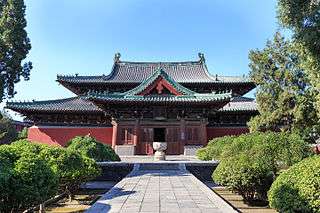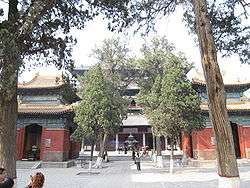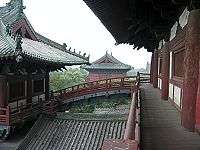Longxing Temple
| Longxing Temple | |
|---|---|
 The Manichean Hall of the Longxing Temple | |
| Basic information | |
| Location | Zhengding |
| Geographic coordinates | 38°8′38.91″N 114°34′33.86″E / 38.1441417°N 114.5760722°ECoordinates: 38°8′38.91″N 114°34′33.86″E / 38.1441417°N 114.5760722°E |
| Affiliation | Buddhist |
| Province | Hebei |
| Completed |
1052 CE Song Dynasty |
The Longxing Monastery or Longxing Temple (Chinese: 隆興寺; pinyin: Lóngxīng Sì) is an ancient Buddhist monastery located near the town of Zhengding in Hebei Province, China, approximately 15 kilometers north of the provincial capital of Shijiazhuang. It has been referred to as the "First Temple south of Beijing".
History

The monastery was first built in 586 AD, during the Sui Dynasty. Its original name was Longcang monastery (Chinese: 龙藏寺; pinyin: Lóngcáng Sì). One of the oldest stelae on the grounds of the monastery, the "Longcangsi Stele" (Chinese: 龙藏寺碑; pinyin: Lóng Cáng Sì Bēi), dates from the year the monastery's foundation. Much of it was reconstructed during the Song Dynasty (960-1279 AD).
Following a common pattern, the monastery complex features a central axis along which a sequence of buildings and focal points is arranged. The first building is the Hall of the Heavenly Kings. At the opposite end of the axis is the Main Hall (Chinese: 大悲阁; pinyin: Dàbēi Gé), a 33-meter-high wooden structure, which houses a bronze statue of Guan Yin. This bronze was built during the early years of the Song Dynasty; its height exceeds 20 meters. Inside the hall, a staircase leads around the statue which allows it to be seen from top to bottom.

Other notable artworks of the monastery are a colorful wooden carving of Guanyin sitting in a grotto and statues of Buddha sitting on a lotus throne.
A unique piece of wood architecture from the Song Dynasty in the Longxing Monastery is the Pavilion of the Rotating Library, which was restored in the 20th century. The pavilion houses a rotating bookshelf which was formerly used to store holy texts and Buddhist sutras. This rotating book case archive dates back to the 12th century, and is the oldest existent rotating repository of its kind (refer to the article Technology of the Song Dynasty).
Today, the Longxing Monastery is open to the public as a museum.
See also
| Wikimedia Commons has media related to Longxing Temple. |